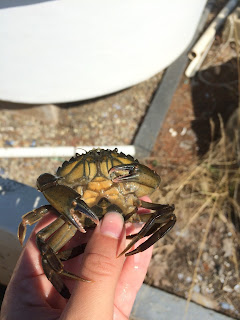This internship has taught me more than I could have ever
expected. Not only have I gained extremely valuable skills from hands-on field
work in coastal science, I have also learned how to be a better person in
general. My favorite thing about working for NH Sea Grant this summer has been
the diversity of experiences I have had.
I learned about sand dune restoration – what plants are
best, how to plant them, and most importantly how to involve the community.
I was also part of the planning stages of a riparian buffer
restoration project for the Sagamore-Hampton golf course. My favorite part
about that project was being a part of the meeting with the owner and the
superintendent of the golf course. It showed that restoration projects require clear
communication between the people implementing the restoration and those who
own/have the most knowledge about the use of the property. It was cool to be a part
of a unique project that can serve as a model for other golf courses in the
area that want to reduce their impact on the Great Bay Estuary.
The eel monitoring project and Lubberland Creek baseline
fish survey with the Coastal Research Volunteers was very eye-opening for me. It
provided me with practice in collecting field data, but also with teaching
others how to collect data too. It was inspiring to meet these volunteers -
people who care deeply about the natural world and take time out of their day
to contribute to local research. More
proof that science couldn’t happen without the cooperation of people.
One of the best parts of this internship was the experience
of working under Alyson Eberhardt and having Myrilla Hartkopf as my partner.
Alyson showed me how to be a more organized person and to give my attention and
effort to the task at hand no matter how many other things are going on. She always kept us on our toes and challenged
us to try new things, and this helped us grow as aspiring scientists and
citizens. I have never worked as closely with a coworker as I did with Myrilla.
We were partners for every project and task that Alyson gave us, and as someone
used to working on things alone this helped me become a better team member and
coworker. If problems came up, Myrilla and I were able to trouble-shoot them
together instead of always having to ask Alyson for help.
Walking away from this internship and into my final year as
an undergraduate at UNH, I am more prepared and aware to enter the world
outside of college. The connections and friendships I have made through this
internship serve as a support system for me as I continue my journey. The
experience and skill I have gained in coastal research and citizen science
empower me to help with related projects in the Seacoast area and other places
in the world.
Thank you NH Sea Grant and those who support them, it has
been an amazing summer.
Best regards,
Molly

















